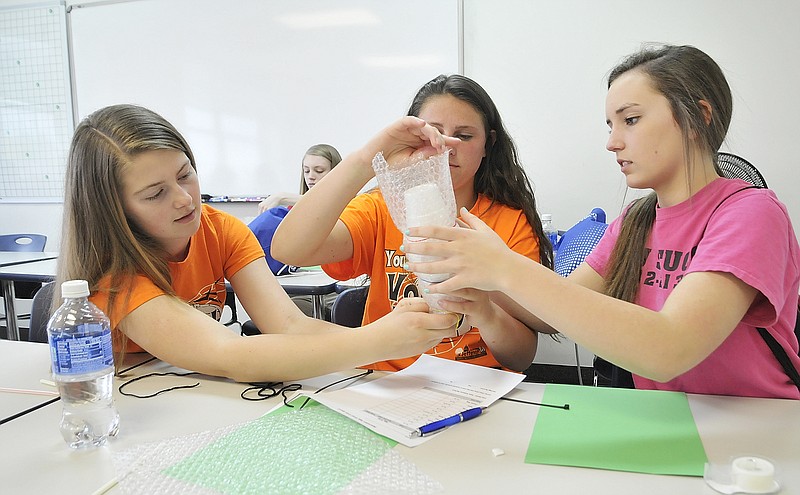Abby Kluttz and Madeline Wilson were worried about their egg.
The ninth-graders from Calvary Lutheran High School in Jefferson City were competing in Operation Egg Drop, a challenge created by the Missouri Department of Transportation (MoDOT) for Lincoln University's annual Math for Girls Day.
Wilson and Kluttz were two of the 70 middle and high school girls who gathered bright and early Friday morning at LU to learn how mathematics is related to potential careers. With this particular task, girls competed to create a device that would protect an egg from a three-story fall.
Kluttz and Wilson's problem wasn't really about the egg, per se. Their egg sat comfortably in a Styrofoam cup. They then cushioned it with a blue balloon and swathed it in bubble wrap.
"Tada! Cushion," Kluttz said.
Since they were preparing to throw it down from three stories, they attached a couple of plastic bags to parachute the egg to the sidewalk below.
The egg was well-protected, and they surmised it would probably land safely on the ground. Kluttz's and Wilson's real problem was financial.
Their egg transportation system cost $5.10 - a hypothetical price, but still too expensive. The girls were vying for the top prize, a MoDOT mug, which would be awarded to the team with the cheapest carrier to land with an uncracked egg.
"You have to think about what materials will be the best packaging for your egg," Elizabeth Reed, senior HR specialist at MoDOT, told the girls. "But what we're looking for is the egg that survives the fall, but is also the least expensive."
According to the MoDOT-prepared cost sheet, the priciest items were $1 sheets of bubble wrap and plastic bags.
Kluttz and Wilson decided they could spare a bag. The egg-carrier now costs $4.10.
Their egg landed intact, but the girls couldn't beat a competing team who spent $2 to protect their egg in a cup outfitted with cushioning, but no parachute.
Kluttz and Wilson weren't too disappointed.
"Our egg was so graceful as it fell," Wilson said. "It was fun."
The MoDOT egg drop was one of several workshops teaching girls about real-world math skills throughout the day.
In one workshop, students played with frequencies on computers to produce different musical notes in a workshop taught by David Heise, associate professor of computer science at LU. In another session hosted by LU's nursing faculty, students solved ratio and proportion problems to prescribe simulated medication to patients. At the end of the day, LU's 4-H Robotics Club showcased its robots to students to demonstrate math applications in engineering.
Before the workshops, girls began their day with a math competition. Divided into teams of three and four, they rotated between stations to solve word problems ranging from algebra to calculus.
"I liked how we had to bounce ideas off of our team members whenever we were doing the competition," said Sasha Campbell, an eighth-grader from Lewis and Clark Middle School.
Fellow eighth grader Jerica Breedlove agreed.
"You learned a lot of other skills besides just math, like teamwork and problem-solving," she said.
Math for Girls Day is meant to encourage young women to participate in and have fun with STEM subjects - science, technology, engineering and math - fields traditionally dominated by men, according to Donna Stallings, assistant professor of mathematics at LU.
"It's not necessary for people who are already high achievers," Stallings said. "It's really to take those students who are at that C-level who are still trying to decide if they want to be interested in mathematics and to spark their interest in math."
In 2006, Stallings applied for a grant from the Association of Women in Mathematics to host a Math for Girls Day at LU. She received the funding, and schools from Jefferson City and occasionally St. Louis and Kansas City have been sending their girls to participate ever since.
Even teachers had a chance to compete. Participating teachers created their own online lesson plans to incorporate Internet activities with mathematics.
For many participants, students and teachers alike, Math for Girls Day was more than an excuse for a free day from school.
"I liked learning math while working with other people in a different environment than school," Breedlove said. "It's a great thing to do with friends."

